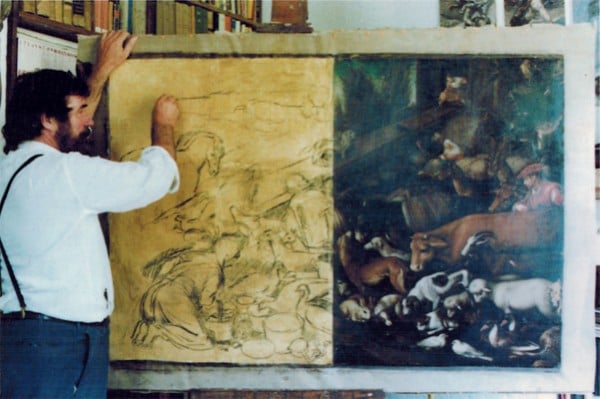Auctions
Master Forger’s Drawings Spur Bidding Frenzy
Are Eric Hebborn’s fakes better than the real thing?

Are Eric Hebborn’s fakes better than the real thing?

Coline Milliard

Sometimes it’s not about getting the real deal. A collection of 234 pieces by the late English art forger Eric Hebborn sold at auction on Wednesday for over £50,000 (about $79,000), more than five times their collective higher estimate. “We are just a small auction house near Salisbury,” Hamish McFall, director at auctioneer Webbs of Wilton, told the BBC. “It is phenomenal.”
The collection gathered pieces realized in the style of Old Masters as well as Hebborn’s well-thumbed drawing textbook. The latter fetched a handsome £3,000 (about $4,700). One of his tricks was to invent preparatory drawings for existing paintings, most famously Anthony van Dyck’s The Crowning With Thorns, which he studied in a German museum.
Hebborn is thought to have forged around 1,000 pieces over the course of his career. And he fooled some of the world’s leading institutions, among them, the British Museum in London and the Metropolitan Museum of Art in New York. Curator Nicholas Turner claimed to have identified several of his fakes, including pieces at the J. Paul Getty Museum in Los Angeles, the Courtauld in London, the Met, and the Cleveland Museum of Art.
The mystery surrounding Hebborn has no doubt played a part in his appeal. In 1996, the forger was found with his skull crushed in the streets of Rome, where he had spent the last 30 years of his life. The murder has remained unsolved to this day.
At the time of Hebborn’s death, the head of the Italian police division responsible for art told the Independent, “Sometimes his work was more beautiful than the original.”
Collectors certainly agree. At the Webbs of Wilton sale, over 255 bidders fought over the artworks, which had been recovered from Hebborn’s Roman flat after his murder.
High-Profile Fraudsters
It isn’t unusual for fakes to become sought-after artworks in their own right. Once uncovered, several high-profile fraudsters have made a career out of their artistic skills. John Myatts—once dubbed “the biggest art fraud of the 20th century” by Scotland Yard—is now producing “legitimate fakes,” which can fetch up to £15,000 (about $24,000) a pop. Even the infamous Wolfgang Beltracchi sells his imitations, ranging from Max Ernst to Heinrich Campendonk (see What You Need to Know about Master Forger Wolfgang Beltracchi’s Latest Antics).
The Hebborn sale, however, could have serious implications for institutions across the globe, if any still hold some of his work in store. According to Webbs of Wilton’s McFall, buyers are likely to try and find links between their purchase and artworks housed in museums. “Obviously, if they’re able to trace it, then the value of the piece increases,” the auctioneer told the BBC. “There will be people looking around in the next two to three years and I think all kinds of things will come out of the closet.”